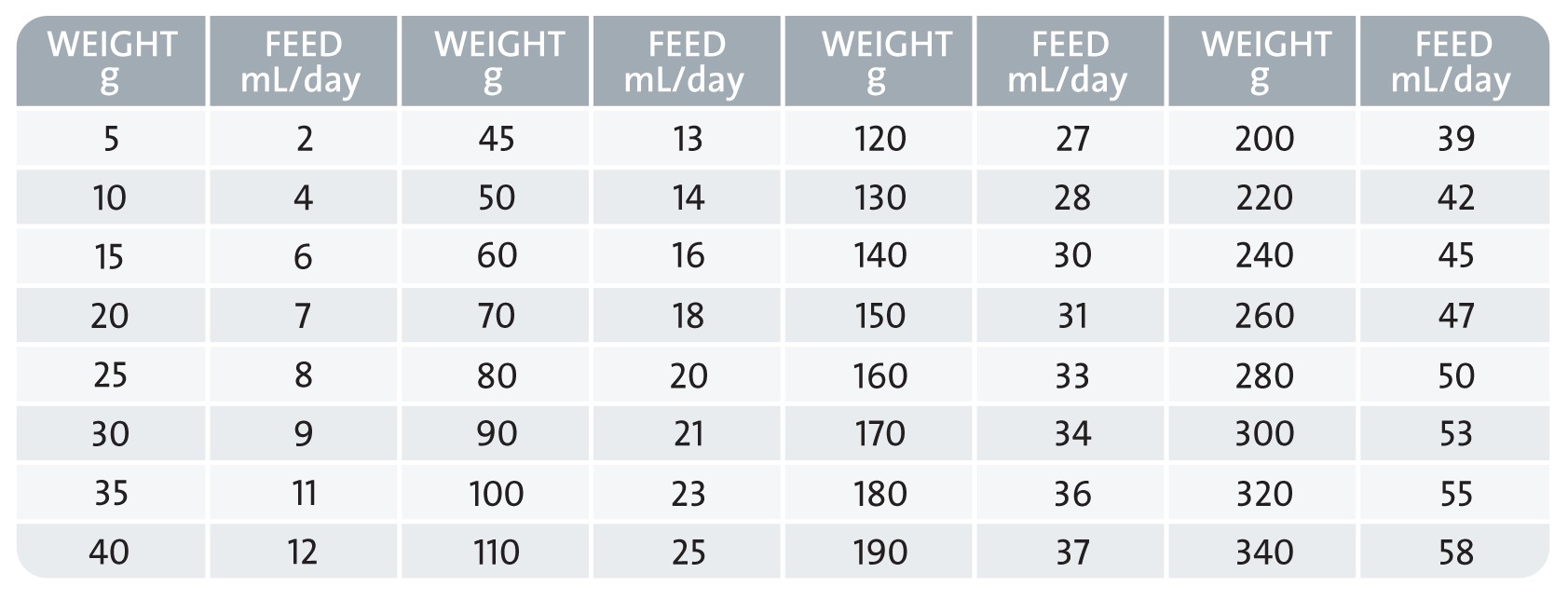Milk substitute for wombat joeys with less than 40% of their pouch life completed.
Joeys at this stage are furless, pink skin, eyes closed, ears down. Entirely pouch bound. Faeces yellow custard consistency.
Key Features
- Specifically formulated to match the composition of early lactation wombat milk.
- Low energy milk, with a low fat content.
- Easily digested carbohydrates and proteins.
Ingredients
Whole milk solids (low lactose), whey protein, casein, glucose, vegetable oils, omega-3 & 6 fatty acids, maltodextrin, vitamins A, B1, B2, B3, B5, B6, B9, B12, C, D3, E, K, biotin, choline, calcium, phosphorus, potassium, sodium, magnesium, zinc, iron, manganese, copper, iodine, selenium.
Typical Analysis
| Protein |
36% |
| Fat |
14% |
| Ash |
4% |
| Moisture |
3% |
| Energy (ME) |
18 MJ/kg |
Pack Sizes
140g & 700g.
Use Wombat Milk Replacer <0.4 for very young “pinkies” during early lactation. Joeys at this age are very immature and may not be viable. They should only be attempted by experienced carers with the correct equipment and resources.
Impact Colostrum Supplement may be fed to enhance the immune system.
Making up Milk
To make 100 mL of milk: Mix 14g of powder (2 scoops) with 95ml of warm water.
To make 1 litre of milk: Mix 140g of powder with 950ml of warm water.
Add about half of the water to the powder first and mix to a paste. Then make up with remaining water and mix thoroughly. Water is preboiled to ensure that it is sterilised. If the water is too hot it can cause the milk to curdle. If it is too cold then it will be difficult to disperse the powder. An electric whisk can be used for mixing larger quantities. Milk can be stored in the fridge for a day or can be frozen for up to 2 weeks. It may be useful to store frozen milk in small portions (e.g. ice cube trays), so that the required daily feed volumes can be easily thawed out. Once thawed out, discard any unused milk, and wash feeding utensils thoroughly.
Feeding Guide

Warm milk to about 30°C and feed using a bottle and teat. An STM Teat or syringe is recommended for small in-pouch wombats. Feed at least 8 times per day for joeys with an Age Factor <0.4. If the joey is showing signs of dehydration (e.g. during hot weather), give extra drinks of water between feeds. Very young joeys dehydrate rapidly if not maintained under optimum husbandry conditions. Consult your veterinarian or experienced carer for further information about husbandry and feeding of joeys.
Growth
Refer to the Common (Bare-nosed) and Southern Hairy-nosed Wombat growth charts. Even within species there may be significant variation in growth rate depending on sex, regional variation and health status. Weigh joeys regularly to verify weight gains and determine the volume of milk to feed. Overfeeding milk can cause diarrhoea so feed the suggested volumes in our tables.
Transition from Wombat <0.4 to Wombat 0.4 formula
Milk transition refers to when a joey is changed from one Wombaroo milk stage to the next. It is important to transition joeys at the correct age to ensure they are getting the proper nutrition for their stage of development. Note that transition is dependent on joey age and not weight, as underweight joeys still need to be transitioned at the correct time. When ears just start to become upright, joeys are ready to transition onto Wombat Milk Replacer 0.4 formula. Joeys are gradually transitioned over 10 days by mixing decreasing amounts of the <0.4 formula with increasing amounts of the 0.4 formula. This is outlined in the species growth charts.







